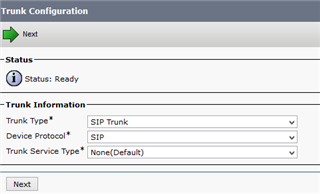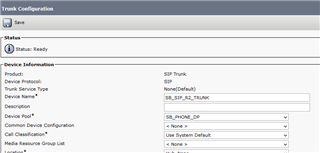L'objet de cet article est de configuré l'intégration sur le site SB entre le cucm et le routeur voix en sip.
Étapes de configurations:
1 - Vérification du matériel:
SB#show inventory
NAME: "2811 chassis", DESCR: "2811 chassis"
PID: CISCO2811 , VID: V04 , SN: FTX1124A3YE
NAME: "2nd generation two port FXO voice interface daughtercard on Slot 0 SubSlo
t 0", DESCR: "2nd generation two port FXO voice interface daughtercard"
PID: VIC2-2FXO , VID: V01 , SN: FOC10480ER8
NAME: "One port T1 voice interface daughtercard on Slot 0 SubSlot 1", DESCR: "On
e port T1 voice interface daughtercard"
PID: VWIC-1MFT-T1= , VID: 1.0, SN: 35227201
NAME: "4 Port FE Switch on Slot 0 SubSlot 2", DESCR: "4 Port FE Switch"
PID: HWIC-4ESW , VID: V01 , SN: FOC15240T7P
NAME: "WIC/VIC/HWIC 2 Power Daughter Card", DESCR: "4-Port HWIC-ESW Power Daught
er Card"
PID: ILPM-4 , VID: V02 , SN: FOC15233SFV
NAME: "WAN Interface Card - Serial (1T) on Slot 0 SubSlot 3", DESCR: "WAN Interf
ace Card - Serial (1T)"
PID: WIC-1T= , VID: 1.1, SN: 9937053
NAME: "PVDMII DSP SIMM with four DSPs on Slot 0 SubSlot 4", DESCR: "PVDMII DSP S
IMM with four DSPs"
PID: PVDM2-64 , VID: V01 , SN: FOC10221QK0
2- Activation du port T1
card type t1 0 1
3- Configuration horloge
SB(config)#network-clock-participate wic 1
SB#show network-clocks
Network Clock Configuration
---------------------------
Priority Clock Source Clock State Clock Type
10 Backplane GOOD PLL
Current Primary Clock Source
---------------------------
Priority Clock Source Clock State Clock Type
10 Backplane GOOD PLL
SB(config)#network-clock-select 1 t1 0/1/0
SB#show controllers t1 0/2/0
T1 0/1/0 is up.
Applique type is Channelized T1
Cablelength is long gain36 0db
No alarms detected.
alarm-trigger is not set
Soaking time: 3, Clearance time: 10
AIS State:Clear LOS State:Clear LOF State:Clear
Version info Firmware: 20090113, FPGA: 20, spm_count = 0
Framing is ESF, Line Code is B8ZS, Clock Source is Line.
CRC Threshold is 320. Reported from firmware is 320.
Data in current interval (295 seconds elapsed):
0 Line Code Violations, 0 Path Code Violations
8 Slip Secs, 0 Fr Loss Secs, 0 Line Err Secs, 0 Degraded Mins
8 Errored Secs, 0 Bursty Err Secs, 0 Severely Err Secs, 0 Unavail Secs
Data in Interval 1:
0 Line Code Violations, 0 Path Code Violations
6 Slip Secs, 0 Fr Loss Secs, 0 Line Err Secs, 0 Degraded Mins
6 Errored Secs, 0 Bursty Err Secs, 0 Severely Err Secs, 0 Unavail Secs
Data in Interval 2:
3 Line Code Violations, 4 Path Code Violations
0 Slip Secs, 0 Fr Loss Secs, 2 Line Err Secs, 1 Degraded Mins
2 Errored Secs, 0 Bursty Err Secs, 0 Severely Err Secs, 0 Unavail Secs
Total Data (last 2 15 minute intervals):
SB#show network-clocks
Network Clock Configuration
---------------------------
Priority Clock Source Clock State Clock Type
1 T1 0/1/0 GOOD T1
10 Backplane GOOD PLL
Current Primary Clock Source
---------------------------
Priority Clock Source Clock State Clock Type
1 T1 0/1/0 GOOD T1
4- Définir le global switch type:
SB(config)#isdn switch-type primary-ni
5- Configuration du controleur T1: les commandes vont automatiquement générer l'interface série et le port voix pour être utilisé pour la signalisation ISDN D-Channel.
SB(config)#controller t1 0/1/0
SB(config-controller)#pri-group timeslots 1-3
SB#show run interface serial 0/1/0:23
Building configuration...
Current configuration : 138 bytes
!
interface Serial0/1/0:23
no ip address
encapsulation hdlc
isdn switch-type primary-ni
isdn incoming-voice voice
no cdp enable
end
SB#show run | sec voice-port
voice-port 0/0/0
voice-port 0/0/1
voice-port 0/1/0:23
SB#show isdn status
Global ISDN Switchtype = primary-ni
ISDN Serial0/1/0:23 interface
dsl 0, interface ISDN Switchtype = primary-ni
Layer 1 Status:
ACTIVE
Layer 2 Status:
TEI = 0, Ces = 1, SAPI = 0, State = MULTIPLE_FRAME_ESTABLISHED
Layer 3 Status:
0 Active Layer 3 Call(s)
Active dsl 0 CCBs = 0
The Free Channel Mask: 0x80000007
Number of L2 Discards = 0, L2 Session ID = 1
Total Allocated ISDN CCBs = 0
6- Configuration SIP globale sur le routeur:
SB(config)#voice service voip
SB(conf-voi-serv)#no ip address trusted authenticate //désactivation juste pour les besoins du lab
SB(conf-voi-serv)#allow-connections h323 to sip
SB(conf-voi-serv)#allow-connections h323 to h323
SB(conf-voi-serv)#allow-connections sip to sip
SB(conf-voi-serv)#allow-connections h323 to h323
SB(conf-serv-sip)#bind control source-interface fastEthernet 0/1
SB(conf-serv-sip)#bind media source-interface fastEthernet 0/1
7- Configuration des dial-peer sur le routeur:
SB(config)#voice class codec 1 //création d'une classe pour la négociation des codecs
SB(config-class)#codec preference 1 g711ulaw
SB(config-class)#codec preference 2 g729r8
SB(config)#dial-peer voice 1 pots //dial-peer POTS
SB(config-dial-peer)#incoming called-number . //match n'importe quel DNIS
SB(config-dial-peer)#direct-inward-dial //empeche un comportement type "two-stage dialing"
SB(config)#dial-peer voice 10 voip
SB(config-dial-peer)#destination-pattern 3123332...$
SB(config-dial-peer)#session protocol sipv2
SB(config-dial-peer)#session target ipv4:10.10.23.11
SB(config-dial-peer)#voice-class codec 1
SB(config-dial-peer)#dtmf-relay rtp-nte sip-notify
SB(config-dial-peer)#no vad
8- Configuration Cisco Call Manager:
Device- Trunk:





